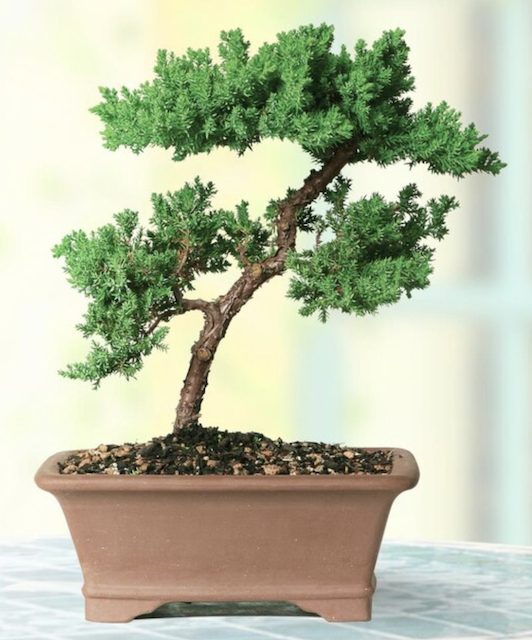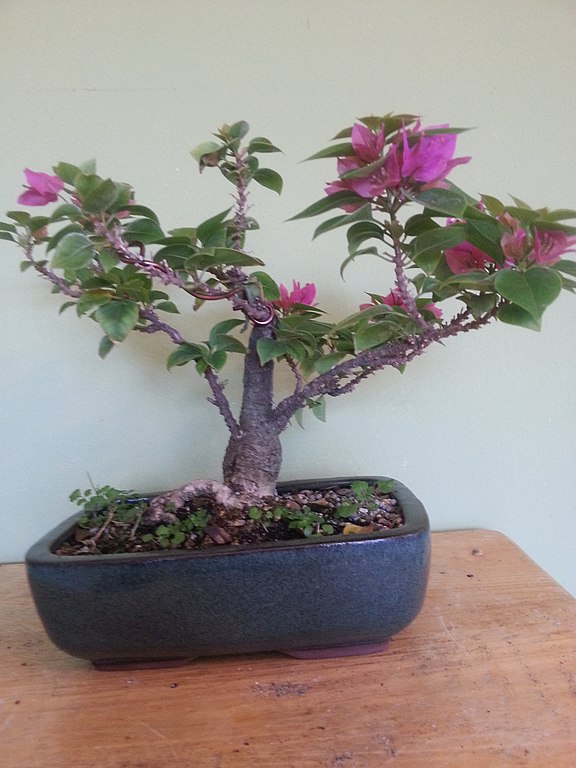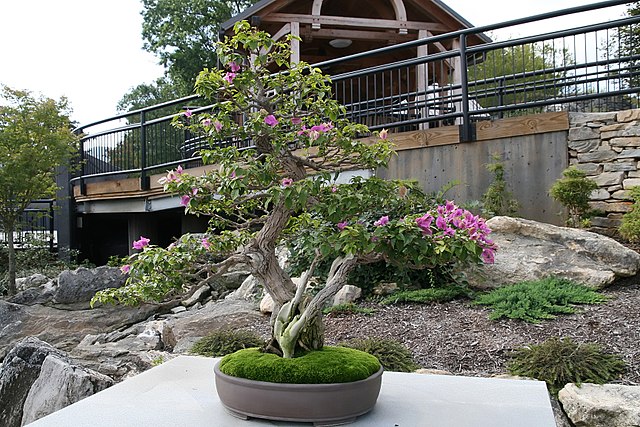Mistakes and Misconceptions
There are a lots of misconceptions about bonsai. Let’s dispel some common ones.
All bonsai trees must be kept indoors.
This one misconception kills thousands of novice’s starter trees every year. There are species that can be grown indoors, while others must be kept outdoors. A few species can tolerate being either place, but do best if they go outside for at least part of the year.
Take a look at this typical tree you might find at a big box store. Often these trees are not healthy to begin with, having been shipped long distances with limited light, air, or water. Adding to its woes, the tag’s care instructions say to keep it indoors, which will kill this tree. It is a juniper (a strictly outdoor species), and should only be indoors for a few days at a time. It must have strong summer sun AND freezing cold each year to thrive.

For comparison, look at the dwarf cultivar of bougainvillea below. Grown from a cutting, this tree has just started training. While it still is young it already has several traits that suggest it could be a very nice bonsai within just a few years.

Bougainvillea grows outdoors as a landscape vine in southern California and Florida. Here in North Carolina, bougainvilleas prefer to spend summers outdoors but need to be brought indoors to protect them from cold in fall and winter.
Bonsai are special tree species.
Generally no. The species we use are the same ones you find in the regular nursery trade. What is different is how the trees’ growth is managed.
There are certain species and cultivars that we like to use because they have desirable traits like short twiggy branches or small leaves, but these are not unique to bonsai. For example, there are several Japanese mapple cultivars that are naturally dwarf, with tiny leaves compared to full size cultivars like Bloodgood. The dwarf cultivars take less time to develop into attractive specimens. The trade-off is they take a long time to develop thick, tapered trunks.
For example the bougainvillea below is a more mature tree that has been in training for several years. Despite all of the years of training, if it were taken to California and planted in open ground, it would grow and behave like a landscape vine.

There ARE tree species that simply do not tolerate the training process; “do not bother” species are determined largely by trial and error. For example, Carolina dogwood seems like it would make an exceptional bonsai, but it does not tolerate root disturbance. It invariably dies after being root pruned.
Bonsai trees are twisted and gnarled because they are tortured and unhealthy.
Definitely not true. Above all else, trees need to be healthy. Twisted twiggy branches and thick rough bark are the result of manipulating a tree’s growing conditions. Unhealthy trees do not respond to these manipulations well.
A common saying in bonsai circles is, “It is impossible to style a dead tree.”
It is better to start with a small tree in a small container.
No, but in some ways yes. A small tree is harder to keep healthy because there is less soil, and less room to make mistakes in watering. Larger containers provide more stable conditions for the roots. The trade-off is that larger trees and containers are more expensive, which can put off novices.
Bonsai artists use ancient, secret techniques that are hard to learn.
Sorry to ruin the mystery, but no. Bonsai artists rely on known principles of plant biology and good horticultural practices. Novices can learn most of the basic skills needed fairly quickly from any number of good books. It helps if you have a more experienced guide, but if you are willing to lose some trees in training, you can teach yourself.
Many bonsai stylists have invested in specialized tools, but mainly to make certain tasks easier. Novices can put together a working set of basic tools from what they probably already have at home.
All materials for bonsai have to come from Japan.
Nope. Some stylists prefer to purchase specialty soil imported from Japan, but many more make soil from materials available locally. Starter trees usually come from US or even local nurseries. Even show containers are now readily available from US potters. Tools may come from Japan, China, or Korea simply because that is where they are available.

Except where noted otherwise, this work is licensed under a Creative Commons Attribution-NonCommercial-ShareAlike 4.0 International License.